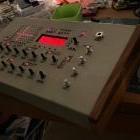-
Posts
352 -
Joined
-
Last visited
-
Days Won
15
jaytee last won the day on August 23 2019
jaytee had the most liked content!
jaytee's Achievements

MIDIbox Tweaker (3/4)
29
Reputation
-
Thanks!
- 135 replies
-
- line driver
- cv/gate
-
(and 2 more)
Tagged with:
-
Hey there getting some more work done on my euro modules that I hope to connect to my MB-6582 (I know Ive been working on this for like three years, lmao, always something else I need to do first). Anyway, just trying to get a handle on the USB port on the euroceiver module. It is *exclusively* used as a 5V power input, correct? But...what is the intended use case for that scenario? with the onboard vreg *and* the option to get 5V from the euro power bus, I can't think of why anyone would ever want to pump in 5V over USB from the front? Can the gate/CV modules also run from the USB 5v or something? I'm designing my own panel that combines the euroceiver, one gate out module, and one CV out module. Is it chill to just leave the USB port off the board and close up that hole in the panel? or is there an important reason to keep it around that I'm just missing?
- 135 replies
-
- line driver
- cv/gate
-
(and 2 more)
Tagged with:
-
With all due respect…this is pretty ridiculous. *All* digital hardware is made with analog parts—it’s transistors all the way down. *All* electronic hardware, digital or analog, warms up in use—no electronic component is perfectly efficient; they’ll all have waste heat. The SID isn’t running DSP algorithms, but that doesn’t make it any less digital. (Arguably it’s *more* digital, as modern DSP can produce waveforms that are basically indistinguishable from analog, while the SID…doesn’t.) All this about the SID’s analog filter having some “magic” that a DSP emulation lacks… The SID filter sucks, y’all. Especially the 6581 filter, with the wimpiest resonance I’ve ever heard in my life, but even the 8580/6582 filter is nothing amazing. It does its job but lacks any of the character people love vintage synths for—and fwiw, even those character-ful filters like the Moog ladder or TB-303 are emulated pretty nicely in DSP these days. It’s funny because if you go back about a decade or so, one of the primary concerns among the MIDIbox SID community was how to improve the lackluster analog filters! We tried swapping out the filter caps, trying different values and dielectrics. TK added CV control to the MB SID to allow for much beefier external filters to be used. Seppoman built a PCB for installing SSM2044 filters internally. And the MB-6582 has those feedback knobs which serve primarily to overdrive the filter and improve the resonance—*anything* to give the crappy filter a little more oomph. Now, of course, none of this is to say that the SID emulations sound as good as the originals. That’s a subjective measure, and everyone’s entitled to their opinion of course. But let’s not start with talk of how analog is “magic” or how 80s digital is somehow “more analog” than 2020s digital. It’s silly.
- 88 replies
-
- sid replacement
- sid clones
-
(and 4 more)
Tagged with:
-
Busy with some paying projects at the moment so I haven’t yet built up the various modules, BUT I did take a moment today to open up my MB-6582 and confirmed that the midiphy version of the line driver PCB fits inside the chassis, mounted to the back panel, with plenty of room to spare. I suspect the standard line driver PCB would also fit fine. Not a big deal but it had been on my mind as a possible hang-up point for this project. Happy to have it confirmed.
-
Just casually bumping this thread after two years. Obviously a lot happened in the world since I made this post,but I’m finally about to get around to building these MIDIphy modules. Nothing to actually report yet, but I thought maybe others might be interested in progress on this project.
-
Sorry, could be clearer I guess. I’ll break it down. You need a connection between V3’s input and 15V. Yes, as you say, J72 is already connected to V3’s input. I am not instructing you to connect these two points. I am just telling you that J72 is a convenient place to solder a jumper wire. With a wire connected to J72 at one end and 15V on the other end, you will have successfully made the connection between V3’s input and 15V. Not sure what you mean in your second comment there. Solder it all, no need for a removable cable.
-
I got my MB-6582 hooked up with all the individual outs for the first time about a week ago. It just occurred to revisit this issue. I just double checked and still don’t seem to have this behavior. My interface and my MB6582 may be on different outlets, I haven’t checked, not sure if that would affect it. Maybe it also matters what kind of power bricks are used? I’m still kinda confused about how this was working, lol, I can’t figure out why it would only apply to the individual outs and not the mix out...
-
A different length of trigger will probably affect the sound, since it’s an analog circuit. Still might be worth trying though...
-
Why does it need to use a 4016? I don’t know what to plug into that MFOS circuit, but it seems like a 555 in monostable mode will do the trick, no?
-
Nice! That would have stumped me.
-
If you’re only briefly showing continuity when you first connect your probe (ie you get a short beep but then everything seems good) then it’s probably fine. That will often happen because your meter is charging a capacitor, allowing current to flow, which very briefly looks like continuity to the meter.
-
Ah, sorry, replied on your other thread, didn’t see that you had posted here and already gotten the same advice.
-
Thanks for the encouraging words! I feel like it *should* pretty much just work, but of course I’m sure there will be some hiccups along the way. I think the Bass Engine will be particularly fun with CV and gate outputs. Lead engine seems like it adds basically an entire rack of modules to a modular system.
-
Doublecheck first to see if any two of the regulator’s three legs are short-circuited (three total continuity tests). If the other rails are good, sounds like it may be a short between 5V and gnd? If you find a short, you may or may not need to replace the regulator; some are well protected and will just start working again while others will fry. If you don’t find a short between two rails...it probably still failed for a reason so probably worth it to triple-check your work (jewler’s loupe can be had for cheap on eBay!) Otoh, sometimes shit fails for no apparent reason and it’s just a bad part that needs replacing. Or sometimes you accidentally shorted something while working and didn’t realize it till later. Or some other freak occurance that borks your work but otherwise won’t happen again. So don’t stress too much if you can’t find an obvious fault. Try replacing it and if it fails again, then at least you’ve established a pattern and have a better idea what to look for. And if it works, it works.
-
Bumping this thread again now that the modules are available. Anyone familiar enough with the MB SID CV/gate outputs to know how potentially conflicting assignments work? Any other insight re: the questions in my last post? I guess I can always build the modules and just see what happens but it would be nice to have some idea of expected behavior.






